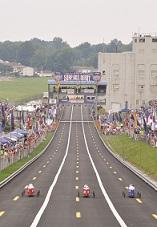

Volunteers are as important as the fields, courts and courses upon which amateur and professional athletes play. They can round out typically lean staffs and provide expanded services most event budgets would otherwise be unable to compensate. Simply put, enlisting interested, motivated and dedicated volunteers must be a key item on every event rights holder’s to-do list.
From small tournaments to national championships, careful planning is required to optimize the roles volunteers will play throughout your event. Not unlike the criteria you develop to hire paid staff, it is critical to have a comprehensive volunteer recruitment, training and retention strategy. Clear goals and objectives will save valuable time and resources by establishing consistent standards and expectations.
But as you move forward in your effort to engage community volunteers, you must know that your needs and requirements are not necessarily always aligned with theirs. Today’s volunteers are becoming increasingly more discriminating in their selection of worthy causes to which they will lend their time and service. Volunteers not only want to engage with events they deem important, but they also want to use their specific skills and talents. Gone are the days of posting a sign-up sheet that would quickly fill with names. A deliberate and systematic approach will reap more mutually-beneficial relationships – the ultimate prize shared between organizers and volunteers. So, how do you tackle the task of engaging volunteers? How do you develop the necessary recruitment, training and retention strategy? It begins by carefully evaluating and prioritizing your event staffing needs.
Needs Assessment
Although the exercise of listing your staffing needs seems elementary, having it down on paper (or computer screen) is a surprisingly effective way to see what you really need your volunteers to accomplish. More importantly, it creates a diverse list of tasks from which your volunteers can choose to dedicate their time. Remember, you may also need help before and after the event, so consider pre- and post-event activities that may need volunteer attention. To ensure your assessment (or ongoing assessment) is comprehensive, invite leadership, staff, seasoned volunteers and even a prospective volunteer or two to the table; when it is viewed from these various perspectives, it is more likely your event will have all bases covered. Once complete, your staffing assessment will create the framework for your strategy. Interestingly, academic research indicates that a volunteer-centric culture, even taking time to author a “volunteer philosophy statement,” can enhance your efforts. Much like corporate mission and vision statements, a declaration underscores your commitment and bolsters a volunteer’s sense of value.
Recruiting Strategy
Whether your event requires a modest number of volunteers or a small army, your approach to engaging their service will be the same. One minor consideration – are you utilizing volunteers in your own hometown or in a community you are visiting? If you are regularly hosting events at home, then you will naturally have a more intimate knowledge of available volunteer resources. When you move your event around your region, state or the country, you will have to rely on your host community’s CVB and/or sports commission for guidance.
Host community CVBs and sports commissions have programs in place from which volunteers can be obtained. Their web sites contain forms that prospective volunteers can use to sign-up, including questions that evaluate availability, interests and skills. These volunteers-in-waiting are poised to lend their helping hands to the sporting events held throughout their community.
As you review your staffing assessment, consider the following variations in your volunteer outreach. Short-term assignments are now the standard, so you must demonstrate flexibility and creativity in assigning tasks. A single day of service is also becoming more popular, becoming a way in which your event is being “auditioned” by someone who may wish to make a long-term commitment.
Sources for volunteers are as varied as the sporting events they will eventually serve. Leaving no stone unturned, consider:
· local businesses
· universities/colleges
· non-profits
· governmental agencies
· youth groups
· neighborhood associations
· faith-based organizations.
As a result, volunteerism’s popularity across all sectors, a growing number of online matching service web sites are now available – filling databases full of volunteer profiles. Your current volunteers can also identify new prospects. Dedicated volunteers become passionate ambassadors – mobilizing likely pre-qualified individuals – confirming the old adage that “working smarter” is preferred to “working harder.”
 A Quick Case Study
A Quick Case Study
In the case of the annual Akron Marathon, three-thousand (3,000) individuals are required to assist staff members with course support, runner support, finish line, kids’ fun run, transportation and the accompanying health and fitness expo. More than sixty (60) sub categories exist within the general categories, each with an array of job descriptions and responsibilities.
Since the inaugural race, officials have been leveraging existing volunteers to grow their ranks; as the number of race participants has grown over the past twelve years, so has the number of volunteers to operate the event. Although race organizers continue to solicit interested individuals and groups through traditional ways (print and electronic communication channels), special attention is given to developing a self-sustaining source of volunteers. Similarly, the FirstEnergy All-American Soap Box Derby is experiencing an influx of volunteers via the corporate community. Area businesses are allowing employees to “volunteer on the clock,” affording them the chance to fulfill community service requirements, to foster team building and to have some fun at the same time too.
Generational differences must also be considered as you develop volunteer messages. In the coming years, Baby Boomers will be a rich source of volunteer service. Present Generation X-ers are service-minded and already incorporate community service into their daily lives; they also wish to pursue leadership roles in organizations they value. Older adults are also giving of their time through volunteer service; you must continue to engage their loyalty and dedication to your event.
The ‘Youth’ generation (Gen Y, Millennials & Digital Natives) must a part of your recruitment mix too. In spite of their own leisure pursuits, they do understand the importance of giving back to their community. Although the content of your message will be the same, differences in the way in which you deliver it will vary – letters, emails, social media posts and face-to-face encounters.
Finally, volunteers are providing increasing input into the tasks they will be asked to complete. With their satisfaction level in mind, develop recruitment tactics that communicate your willingness to “partner” with them to identify needs, determine assignments and set overall event goals.
Training Strategy
Most volunteers will arrive at your event with their sleeves rolled up, all ready to work. With eagerness and enthusiasm on their side, they genuinely want to make the most of their time with you, and they are interested in providing people-power where it is most needed. They also want a full-filling experience, feeling that they have used their time and skills wisely. As with your recruitment strategy, your training strategy must include provisions to boost volunteer satisfaction across their experience.
Volunteers want to support events that have clear and concise actions plans. Tell them what, how, where and when to do a task and their satisfaction soars. If you send them off with nothing more than a “hello, we’re glad you’re here,” then you have set them on a course of frustration and volunteer’s remorse. Training should include: meeting new volunteers to make them feel welcome and appreciated from the start; spending time to explore their interests, their reasons for volunteering and their expectations from your organization; reviewing your event goals, staff and facilities; and outlining specific job responsibilities that match their skills. You must develop volunteer confidence, an important and underlying objective towards achieving overall satisfaction.
Once a volunteer has been dispatched, you will want to maintain open lines of communication. Whether their questions or requests are minor or require serious address, volunteers want to feel completely supported and connected. Some larger events use computerized scheduling programs, offering a real time bridge between volunteers and coordinators.

Retention Strategy
Today, event rights holders are faced with increased competition for volunteers. Potential volunteers have an increasingly-wide array of events to which they can lend their assistance. In addition, they are becoming increasingly protective of their spare time, particularly as it pertains to their personal and family time. Considering everyone’s time-starved, balancing-work-and-home schedules, their decision to volunteer becomes more discriminating than ever. So, it makes perfect sense that if you have recruited and trained a volunteer, you had better do all you can to retain them. And believe it or not, doing so is not especially difficult or costly.
Use yourself as an example here. When you do something above and beyond your normal responsibilities, a simple “thank you” is usually the only thing for which you are looking. It could be an e-mail, a hand-written note or a handshake. By their nature, volunteers are generally humble and only want modest recognitions for their contributions. So make this a top priority. As a matter of fact, make it a volunteer’s job to ensure it gets done. Other items could include: certificates of appreciation, pins/T-shirts, acknowledgment in programs, complimentary tickets to area special events, discounts to local entertainment/dining spots, recognition events and a volunteer courtesy space to rest, grab a cold water and small bite to eat.
Sometimes, and particularly in the case of a sports event, volunteers might be avid fans. There may be no greater reward for them than being able to watch an exciting game, a medal round, or spend time serving the athletes personally. This might be the most important perk you can hand out – and it is completely free.
Aside from these gestures, recruitment retention must include ongoing outreach with the possible use of survey tools to keep your volunteers engaged. Written or online evaluations provide volunteers with a means to share ideas, to explain concerns and to offer solutions. Volunteer feedback will also identify weaknesses in your training strategy, by eliciting possible concerns about unclear job descriptions, unresolved problems or general dissatisfaction. Compiling this information is invaluable as you refine your recruitment and training strategies. The mere fact that volunteers are asked for their input is also valuable.
You must also highlight the variety of benefits afforded volunteers: new friendships, new skills, rewards for involvement, travel opportunities, training and personal development, competition and social events. Remind them that when they are spending time with you, they are helping others, sharing talents, feeling useful and appreciated, being part of a team and most importantly, having fun and enjoying themselves.
A Community of Volunteers
Volunteering is at the heart of community development – and the heart of most cities and towns across this great land pulse from the excitement of youth, amateur and professional sports. Everyone benefits from games, matches and exhibitions. They bring us together. They encourage us to excel. They allow us to celebrate in victory and console each other in defeat.

